Getting to Palacios from Austin involves running down US Highway 183, which goes through a lot of nowhere-in-particular, a succession of small and smaller towns, ranging from vanished communities to wide spots in the road to middle-sized county seats of thirty and forty thousand.
The first piece of nowhere is only “nowhere” if you don’t know anything about Texas beef barbecue. Lockhart, the county seat of Caldwell County, is home to two fine barbecue joints, both the result of a family squabble. The Kreuz family started a meat market in 1900 and later branched out into smoking the meat, which led to people wanting to eat at the market, which led to a very old-fashioned restaurant, where your meal was served on sheets of pink butcher’s paper and eating with your fingers was (mostly) good manners.
The market/restaurant, Kreuz Market, operated in the same building, a block off the courthouse square, for ninety years or so, and ownership eventually came down to two brothers and a sister; the sister owned the building, the brothers the business. They couldn’t agree on how much rent the business should pay for the building, and eventually it turned into a lawsuit over who got rights to the business name and who the location. Finally, a court split the sheets, so to speak, and decided the brothers could keep the name but not the building, so they built a new location on the edge of town, with a grand re-opening where coals from the pit fire, which hadn’t been allowed to go out in eons, were ceremoniously carried at the head of a parade to Kreuz’s new location and used to light the new pit, while the old location renamed itself Smitty’s and kept the fires burning, so to speak. We ate at Smitty’s, where the beef was really as fine as their reputation has it, and the (soupy) frijoles tasted good at least. In the confusion (it was lunchtime, and the place was busy) the potato salad I ordered got lost, but it wasn’t really missed.
Before lunch, we stopped for a few minutes to see the Dr. Eugene V. Clark Memorial Library, built in 1899 and in continuous operation since then. The original library building is a Palladian rotunda, reminiscent of Monticello without the wings, and beautifully restored inside and out. The east wall has an enormous, almost Methodist-looking stained-glass window given in memory of Dr. Clark, the floors are original hardwood polished to a satin shine, and two cast-iron spiral staircases lead to the meeting rooms on the second floor. Tall windows with folding shutters were closed against the sun, and the building made a dim, cool refuge against the heat outside. Some years back, the library ran out of space, so it took over a commercial storefront next door in the first floor of the Masonic Lodge, and connected the two with a closed-in walkway.
Lockhart also has an utterly gorgeous courthouse, restored to nearly original condition a few years ago with a grant from the Texas Historical Commission, and we stood and admired it for a few minutes before we left, which turned out to set the theme for the day. 183 runs through several county seats, almost all of which have Victorian courthouses worth admiring, and we stopped to look at each one.
Lockhart’s courthouse was built in the Second Empire style, as was its twin-sister in Goliad (more later on Goliad). Both were designed by Henry Guidon, one of a whole fistful of architects who specialized in courthouses and other public buildings, and who had excellent grasp of the style and what it could be, and both were built by Martin, Byrne and Johnston of Comanche (yes, the same Comanche where I grew up). The buildings have turrets and ox-eye windows and a clock tower with chimes, and clocks that tell everyone the time just as well as they did a hundred and twenty years ago.
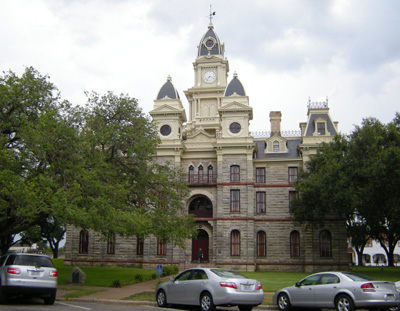
Goliad County Courthouse, west exterior
While we didn’t go inside the courthouse at Lockhart, we did at Goliad, and it was a delight. The restoration brought back the original polychrome stonework, interior tilework, and paint, so even with dark beaded wainscoting, the hallways and offices don’t feel oppressive. We climbed the cast-iron staircase to the second floor, and I pointed out the place on the landing where a hundred years of people’s shoes, turning the corner to go up the next flight, had worn a small circular smooth place in the diamond-grid surface, as well as the carved newel posts.
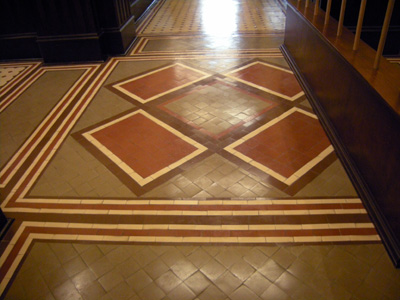
Tilework where the first-floor hallways cross
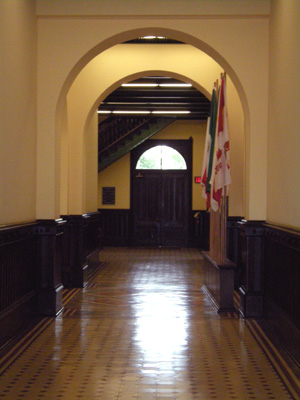
First-floor hallway, looking north
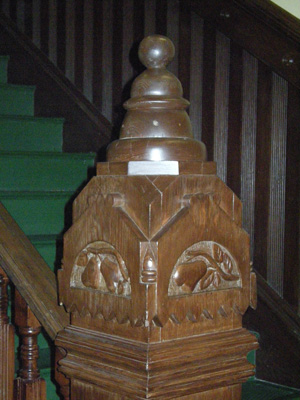
Newel post (note carved pears)
The district courtroom, which occupies half the second floor, was even more wonderful. The restoration had put back the original park-bench type seating, floored the room with a harlequin stained-concrete design in red and gray, refurbished the ornate bronze door handles, and restored the two box galleries at the rear corners.
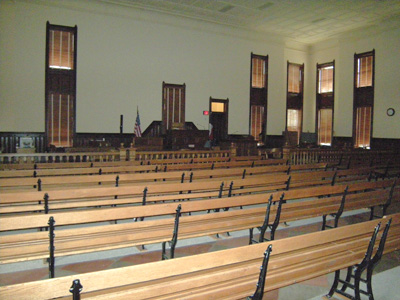
Courtroom benches
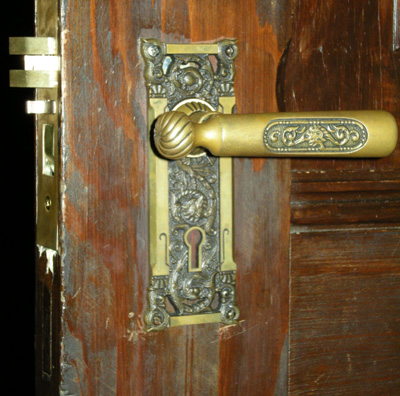
Courtroom door handle and fingerplate
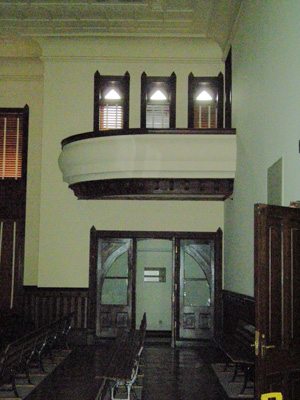
One of the courtroom galleries
After we’d seen all the courthouse anyone cared to see, we made a short detour out to La Bahia presidio and mission, site of the “Goliad Massacre,” where Captain James Fannin and 342 men, all prisoners of war, were executed during the Texas Revolution.
Although it looks like a state monument at first glance, La Bahia is owned and operated by the Catholic Church. The exhibits had a lot of interesting material, but are horribly dated (to my eye, somewhere between 1950 and 1960) and badly need an overhaul. A sign at the entrance said the displays were gradually being brought up to date and that some items were not on display, but I have a feeling it’s one of those projects that only goes by fits and starts and keeps running out of money, so visitors may have to look at exhibit “labels” typed with a manual typewriter on three-by-five notecards for some years to come.
The fort’s parade ground and wall are intact or rebuilt to period, with raised gun platforms and embrasures at each major corner, loopholes for infantrymen to fire through, and a guardhouse on the one corner without a gun platform. L explained to M about the parade-ground well and how it was worked, then we hiked her up to the platform and I explained why embrasures and loopholes are funnel-shaped (gives a wider field of fire, while making it harder for attackers to hit the gun crew). We went back through the enlisted men’s barracks and got to the chapel just in time to dodge a thundershower that had been chasing us for a while and finally caught up.
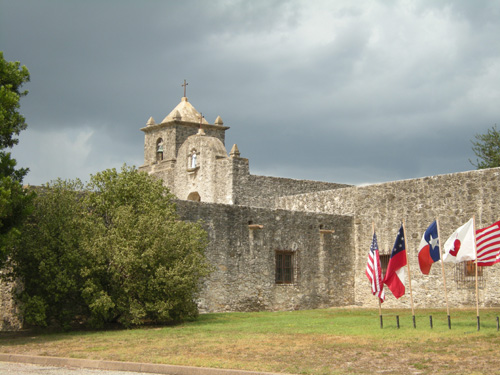
The Loreto chapel and part of the presidio’s wall
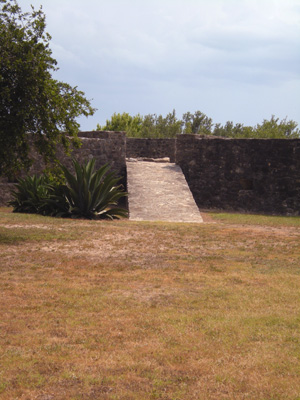
Ramp up to the northeast gun platform
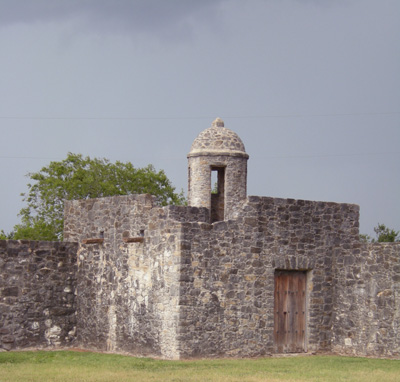
Northwest guardhouse
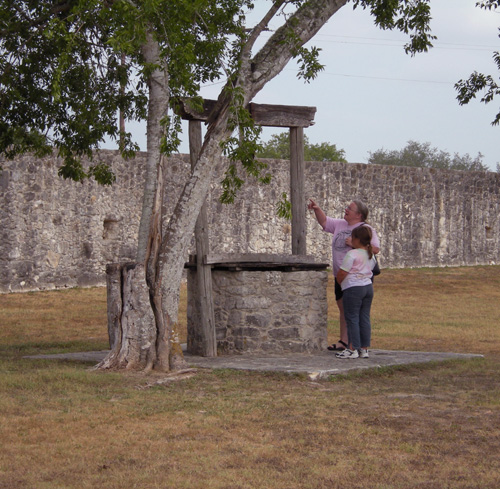
L explains the well to M
Services are still held in the chapel, and the number of votive candles lit before pictures of the Madonna and Child made it clear this was a functioning church. The altar wall is dominated by a huge 1950s fresco of the Annunciation, while a side chapel holds national, state, and city flags representing the origins of every Texan soldier who died at Goliad.
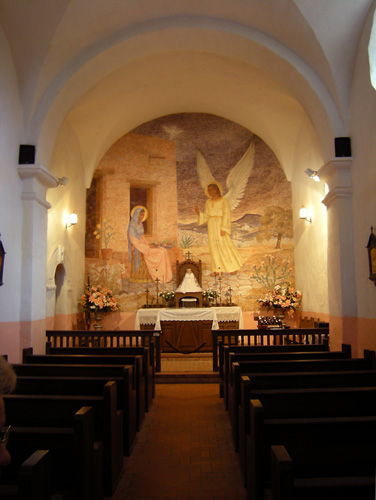
Loreto chapel
Because we’d stayed a while at La Bahia, we didn’t reach Victoria until after 5:00, and their courthouse was already locked up for the holiday weekend. We could only admire the outside, which was certainly worth admiring. It’s yet another of the big fistful of polychrome Richardson Romanesque courthouse structures, recently restored with Historical Commission money, and was remarkable for the stone the original architect specified—a combination of white limestone and a blue-gray sandstone called “blue Muldoon,” after the quarry where it’s found. A historical marker told us the original architect, J. Riely Gordon, was “removed from the project because of his other commitments,” probably meaning he’d taken on too many jobs at once and was never onsite when you wanted him, and the project handed over to Eugene Heiner, another well-known architect of nineteenth-century courthouses, to finish.
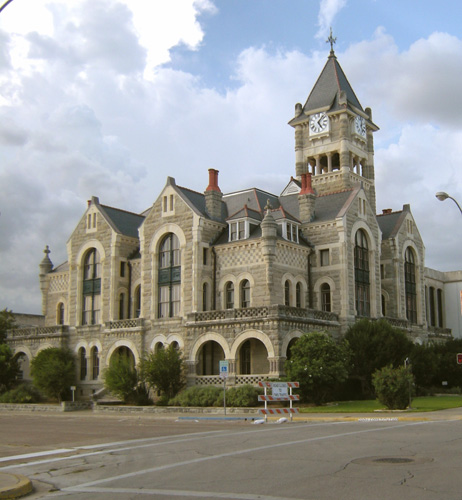
The Victoria County courthouse
Unlike most courthouse “squares” in Texas, where the courthouse is in the center and the commercial district ranged around it, Victoria’s courthouse sits on a half-block lot with a public plaza in front of it, a survival of Mexican city planning concepts.
From Victoria south and east you get to the coastal prairie, a completely flat and uninteresting landscape, unless you’re a connoisseur of grain sorghum fields, and there were a lot of sorghum fields to see. Eventually we turned north to run across the head of Matagorda (“kills-fat”) Bay, and reached Palacios and our hotel by late afternoon.

4 Responses to Independence Day – my holiday(?), part II